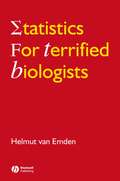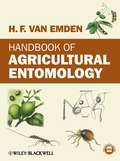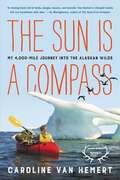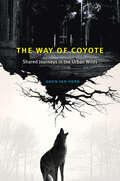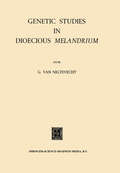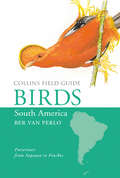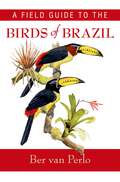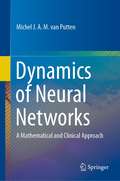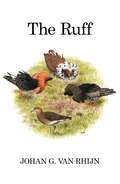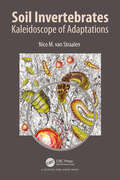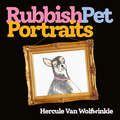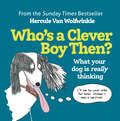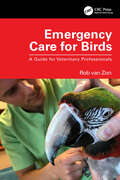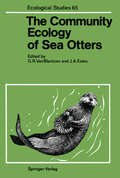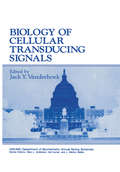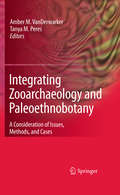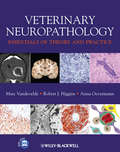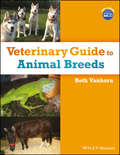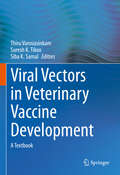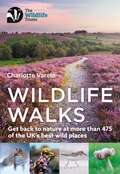- Table View
- List View
Statistics for Terrified Biologists
by Helmut van Emden“We highly recommend it—not just for statistically terrified biology students and faculty, but also for those who are occasionally anxious or uncertain. In addition to being a good starting point to learn statistics, it is a useful place to return to refresh your memory.” –The Quarterly Review of Biology, March 2009 "During the entire course of my Ph.D. I've been (embarrasingly) looking for a way to teach myself the fundamentals of statistical analysis. At this point in my education, I've come to realize that often times, simply knowing the basics is enough for you to properly apply even the most complex analytical methods. ‘Statistics for Terrified Biologists’ has been just such a book - it was more than worth the $40 I spent on it, and while my 'book clubs' aren't meant to be reviews, I highly recommend the book to anyone who's in a similar predicament to my own." –Carlo Artieri's Blog Book Club The typical biology student is “hardwired” to be wary of any tasks involving the application of mathematics and statistical analyses, but the plain fact is much of biology requires interpretation of experimental data through the use of statistical methods. This unique textbook aims to demystify statistical formulae for the average biology student. Written in a lively and engaging style, Statistics for Terrified Biologists draws on the author’s 30 years of lecturing experience. One of the foremost entomologists of his generation, van Emden has an extensive track record for successfully teaching statistical methods to even the most guarded of biology students. For the first time basic methods are presented using straightforward, jargon-free language. Students are taught to use simple formulae accurately to interpret what is being measured with each test and statistic, while at the same time learning to recognize overall patterns and guiding principles. Complemented by simple illustrations and useful case studies, this is an ideal statistics resource tool for undergraduate biology and environmental science students who lack confidence in their mathematical abilities.
Handbook of Agricultural Entomology
by Helmut F. van EmdenHandbook of Agricultural Entomology by Helmut van Emden is a landmark publication for students and practitioners of entomology applied to agriculture and horticulture. It can be used as a reference and as a general textbook. The book opens with a general introduction to entomology and includes coverage of the major insects (and mites) that cause harm to crops, livestock and humans. The important beneficial species are also included. Organisms are described in a classification of insect Orders and Families. The emphasis is on morphological characters of major taxonomic divisions, “spot characters” for the recognition of Families, and the life histories, damage symptoms and economic importance of the various pest species. The book is beautifully illustrated in full colour with more than 400 figures showing both the organisms and the damage caused to plants with diagnostic characters indicated by arrows. Coverage is world-wide and includes much material stemming from the vast personal experience of the author. A companion website with additional resources is available at www.wiley.com/go/vanemden/agriculturalentomology
Handbook of Agricultural Entomology
by Helmut F. van EmdenHandbook of Agricultural Entomology by Helmut van Emden is a landmark publication for students and practitioners of entomology applied to agriculture and horticulture. It can be used as a reference and as a general textbook. The book opens with a general introduction to entomology and includes coverage of the major insects (and mites) that cause harm to crops, livestock and humans. The important beneficial species are also included. Organisms are described in a classification of insect Orders and Families. The emphasis is on morphological characters of major taxonomic divisions, “spot characters” for the recognition of Families, and the life histories, damage symptoms and economic importance of the various pest species. The book is beautifully illustrated in full colour with more than 400 figures showing both the organisms and the damage caused to plants with diagnostic characters indicated by arrows. Coverage is world-wide and includes much material stemming from the vast personal experience of the author. A companion website with additional resources is available at www.wiley.com/go/vanemden/agriculturalentomology
The Sun Is a Compass: A 4,000-Mile Journey into the Alaskan Wilds
by Caroline Van HemertFor fans of Cheryl Strayed, the gripping story of a biologist's human-powered journey from the Pacific Northwest to the Arctic to rediscover her love of birds, nature, and adventure.During graduate school, as she conducted experiments on the peculiarly misshapen beaks of chickadees, ornithologist Caroline Van Hemert began to feel stifled in the isolated, sterile environment of the lab. Worried that she was losing her passion for the scientific research she once loved, she was compelled to experience wildness again, to be guided by the sounds of birds and to follow the trails of animals.In March of 2012, she and her husband set off on a 4,000-mile wilderness journey from the Pacific rainforest to the Alaskan Arctic, traveling by rowboat, ski, foot, raft, and canoe. Together, they survived harrowing dangers while also experiencing incredible moments of joy and grace -- migrating birds silhouetted against the moon, the steamy breath of caribou, and the bond that comes from sharing such experiences.A unique blend of science, adventure, and personal narrative, The Sun is a Compass explores the bounds of the physical body and the tenuousness of life in the company of the creatures who make their homes in the wildest places left in North America. Inspiring and beautifully written, this love letter to nature is a lyrical testament to the resilience of the human spirit.Winner of the 2019 Banff Mountain Book Competition: Adventure Travel
The Way of Coyote: Shared Journeys in the Urban Wilds
by Gavin Van HornA hiking trail through majestic mountains. A raw, unpeopled wilderness stretching as far as the eye can see. These are the settings we associate with our most famous books about nature. But Gavin Van Horn isn’t most nature writers. He lives and works not in some perfectly remote cabin in the woods but in a city—a big city. And that city has offered him something even more valuable than solitude: a window onto the surprising attractiveness of cities to animals. What was once in his mind essentially a nature-free blank slate turns out to actually be a bustling place where millions of wild things roam. He came to realize that our own paths are crisscrossed by the tracks and flyways of endangered black-crowned night herons, Cooper’s hawks, brown bats, coyotes, opossums, white-tailed deer, and many others who thread their lives ably through our own. With The Way of Coyote, Gavin Van Horn reveals the stupendous diversity of species that can flourish in urban landscapes like Chicago. That isn’t to say city living is without its challenges. Chicago has been altered dramatically over a relatively short timespan—its soils covered by concrete, its wetlands drained and refilled, its river diverted and made to flow in the opposite direction. The stories in The Way of Coyote occasionally lament lost abundance, but they also point toward incredible adaptability and resilience, such as that displayed by beavers plying the waters of human-constructed canals or peregrine falcons raising their young atop towering skyscrapers. Van Horn populates his stories with a remarkable range of urban wildlife and probes the philosophical and religious dimensions of what it means to coexist, drawing frequently from the wisdom of three unconventional guides—wildlife ecologist Aldo Leopold, Taoist philosopher Lao Tzu, and the North American trickster figure Coyote. Ultimately, Van Horn sees vast potential for a more vibrant collective of ecological citizens as we take our cues from landscapes past and present. Part urban nature travelogue, part philosophical reflection on the role wildlife can play in waking us to a shared sense of place and fate, The Way of Coyote is a deeply personal journey that questions how we might best reconcile our own needs with the needs of other creatures in our shared urban habitats.
Birds of South America: Passerines (Collins Field Guide)
by Ber Van PerloRecommended for viewing on a colour tablet. South America has long been known for its bountiful flora and fauna. The richness in bird life has attracted visitors from all over the world and has helped to make South America an increasingly popular wildlife tourist spot.
A Field Guide to the Birds of Brazil
by Ber van PerloBrazil's bird diversity is one of the richest in the world. And yet there has never been a comprehensive field guide to this splendid and elusive avifauna. Until now. The carefully vetted text and images are the first to cover the full range of bird life in this vast and varied country. The more than 1800 up-to-date accounts treat the Yellow-nosed Albatross to the Sombre Hummingbird, the Ash-throated Gnat-eater to the Black-bellied Whistling-Duck, Nighthawks and Jacamars to Motmots, Puffbirds, and Peppershrikes. They are all here--every species and many subspecies found in each region of Brazil--with special attention given to the 218 Brazilian endemics. The book is laid out so that the illustrations sit across from the commentary and the distribution maps, so it is easy to use. Also, the author uses short-hand notation throughout, to make the book compact and easy to carry when in the field. For each bird, the scientific, English, and Portuguese name are given as well as detailed information on measurement; identifying features; habitat; voice, song, and call. Distribution maps show the range for each species, also indicating seasonality and occurrence, essential for finding and identifying specific birds. From the equatorial North to the tropics, the introductory paragraphs set the stage in describing Brazil's varied biogeography, climate, geomorphology, and natural vegetation. A list of protected areas of Brazil, information on relevant national and international organizations, a bibliography and further references, and an English-Portuguese dictionary of frequently used terms enhance the user-friendly qualities. Anyone wishing to fully explore the fabulously varied bird life of Brazil will find this light-weight, easy-to-use, attractive guide an invaluable field companion.
Dynamics of Neural Networks: A Mathematical and Clinical Approach
by Michel J.A.M. van PuttenThis book treats essentials from neurophysiology (Hodgkin–Huxley equations, synaptic transmission, prototype networks of neurons) and related mathematical concepts (dimensionality reductions, equilibria, bifurcations, limit cycles and phase plane analysis). This is subsequently applied in a clinical context, focusing on EEG generation, ischaemia, epilepsy and neurostimulation. The book is based on a graduate course taught by clinicians and mathematicians at the Institute of Technical Medicine at the University of Twente. Throughout the text, the author presents examples of neurological disorders in relation to applied mathematics to assist in disclosing various fundamental properties of the clinical reality at hand. Exercises are provided at the end of each chapter; answers are included. Basic knowledge of calculus, linear algebra, differential equations and familiarity with MATLAB or Python is assumed. Also, students should have some understanding of essentials of (clinical) neurophysiology, although most concepts are summarized in the first chapters. The audience includes advanced undergraduate or graduate students in Biomedical Engineering, Technical Medicine and Biology. Applied mathematicians may find pleasure in learning about the neurophysiology and clinic essentials applications. In addition, clinicians with an interest in dynamics of neural networks may find this book useful, too.
The Ruff: Individuality In A Gregarious Wading Bird (Poyser Monographs #67)
by Johan G. Van RhijnThe Ruff is a fascinating species whose elaborate breeding behaviour has captivated ornithologists for decades. Their communal display grounds, or leks, provide an extreme example of a social system widespread in birds and other animals, in which brilliantly plumaged males seemingly compete for the attention of passing females. In this book, Johan van Rhijn explores this complex and intricate drama, both to lay bare the details of the players' private lives, and to provide a means of exploring the wider variety of wader breeding systems. Strands of evidence for all aspects of the Ruffs life, in and out of the breeding season, come together to give a thought-provoking insight into this important area of biology. Specialists and birdwatchers alike will have much to learn from this intriguing story and the insights it provides.
Soil Invertebrates: Kaleidoscope of Adaptations
by Nico M. van StraalenSoil invertebrates make up diverse communities living in soil pores and on the soil surface, digging burrows and tunnels, processing organic matter and interacting with microbes. Soil is also a habitat of growing concern as many human activities cause soil degradation. This book documents the evolutionary history of soil invertebrates and their multitude of adaptations. Soil invertebrates live in a twilight zone: some have gone down to seek stability, constancy and rest, others have gone up and faced environmental variation, heat, cold and activity. And it all happens in a few decimetres, millimetres sometimes. Check out the wonderful life below ground in this book.
Soil Invertebrates: Kaleidoscope of Adaptations
by Nico M. van StraalenSoil invertebrates make up diverse communities living in soil pores and on the soil surface, digging burrows and tunnels, processing organic matter and interacting with microbes. Soil is also a habitat of growing concern as many human activities cause soil degradation. This book documents the evolutionary history of soil invertebrates and their multitude of adaptations. Soil invertebrates live in a twilight zone: some have gone down to seek stability, constancy and rest, others have gone up and faced environmental variation, heat, cold and activity. And it all happens in a few decimetres, millimetres sometimes. Check out the wonderful life below ground in this book.
Rubbish Pet Portraits
by Hercule Van WolfwinkleA hilarious collection of Hercule Van Wolfwinkle's 'extremely realistic' pet portraits. Warning: may not be suitable for anyone who actually likes animals or has the ability to see.
Who’s a Clever Boy, Then?
by Hercule Van WolfwinkleWARNING: NOT SUITABLE FOR ART LOVERS. PERFECT FOR DOG LOVERS. The Sunday Times bestselling author of Rubbish Pet Portraits presents…
Emergency Care for Birds: A Guide for Veterinary Professionals
by Rob van ZonDue to their often small size and unique physical characteristics, birds can deteriorate rapidly in the event of illness and injury. Timely intervention in the event of clinical signs is therefore essential for an optimal prognosis. Authored by avian veterinarian Rob van Zon, this concise, practical guide will help veterinary professionals to provide first aid and emergency care for birds, as well as to instruct clients on providing basic first aid when they are unable to get to the clinic. This full-color book, packed with photographs and anatomy drawings, includes instructions for veterinary professionals on stabilizing sick avian patients and management of many specific emergency situations at the veterinary clinic. This includes guidance for those presented with a moribund, critically ill patient i.e., recognizing and treating hypothermia, hypoxia, hypovolemia and hypoglycemia. The book also lists of alarming signs of disease and toxic plants, and includes clinical procedures, an emergency drug formulary, and bandaging techniques. Finally, it offers guidance to veterinarians giving advice to bird owners for first aid at home.
Emergency Care for Birds: A Guide for Veterinary Professionals
by Rob van ZonDue to their often small size and unique physical characteristics, birds can deteriorate rapidly in the event of illness and injury. Timely intervention in the event of clinical signs is therefore essential for an optimal prognosis. Authored by avian veterinarian Rob van Zon, this concise, practical guide will help veterinary professionals to provide first aid and emergency care for birds, as well as to instruct clients on providing basic first aid when they are unable to get to the clinic. This full-color book, packed with photographs and anatomy drawings, includes instructions for veterinary professionals on stabilizing sick avian patients and management of many specific emergency situations at the veterinary clinic. This includes guidance for those presented with a moribund, critically ill patient i.e., recognizing and treating hypothermia, hypoxia, hypovolemia and hypoglycemia. The book also lists of alarming signs of disease and toxic plants, and includes clinical procedures, an emergency drug formulary, and bandaging techniques. Finally, it offers guidance to veterinarians giving advice to bird owners for first aid at home.
The Community Ecology of Sea Otters (Ecological Studies #65)
by Glenn R. VanBlaricom James A. EstesThe impetus for this volume comes from two sources. The first is scientific: by virtue of a preference for certain large benthic invertebrates as food, sea otters have interesting and significant effects on the structure and dynamics of nearshore communities in the North Pacific. The second is political: be cause of the precarious status of the sea otter population in coastal California, the U.S. Fish and Wildlife Service (USFWS) announced, in June 1984, a proposal to establish a new population of sea otters at San Nicolas Island, off southern California. The proposal is based on the premise that risks of catastrophic losses of sea otters, due to large oil spills, are greatly reduced by distributing the population among two geographically separate locations. The federal laws of the U.S. require that USFWS publish an Environmental Impact Statement (ElS) regarding the proposed translocation of sea otters to San Nicolas Island. The EIS is intended to be an assessment of likely bio logical, social, and economic effects of the proposal. In final form, the EIS has an important role in the decision of federal management authority (in this case, the Secretary of the Interior of the U.S.) to accept or reject the proposal.
Biology of Cellular Transducing Signals (Gwumc Department of Biochemistry and Molecular Biology Annual Spring Symposia)
by Jack Y. VanderhoekIntercellular communication in multicellular organisms enables cells to respond to environmental changes. Intercellular signal transduction transmitters include hormones, peptide growth factors, neurotransmitters as well as some lipid-soluble mediators. Once signalling molecules are bound to their cell surface receptors, one or more intracellular signals are generated which alter the Qehavior of the target cell. The IXth International Washington Spring Symposium at the George Washington University in Washington, D.C. was organized to assess the current status of the field of signal transduction processes and regulatory mechanisms. The symposium was held on May 8-'.2, 1989 and was attended by more than 1000 scientists from 30 countries. Most of the papers presented at the plenary sessions have been collected in this volume. The first section of this book details the action and regulation of receptors such as ,B-pdr.'nergic receptors and receptors for EGF, insulin, leukotrienes, phosphoinositides and prostaglandins. Section two focuses on the family of guanine nucleotide regulatory proteins (G proteins). These G proteins are known to mediate the coupling of receptor-mediated signals to several intracellular effector systems. Papers are presented describing the intracellular localization of G proteins, the utilization of G protein antibodies, the interaction of G proteins with tubulin and the involvement of G proteins in the regulation of ion channels, adenylate cy~lase and in the activation of neutrophils and T cells. In the third section, several papers describe the second messenger role of phosphoinositides as well as the regulation of phosphoinositide production.
Integrating Zooarchaeology and Paleoethnobotany: A Consideration of Issues, Methods, and Cases
by Amber M. VanDerwarker Tanya M. PeresIn recent years, scholars have emphasized the need for more holistic subsistence analyses, and collaborative publications towards this endeavor have become more numerous in the literature. However, there are relatively few attempts to qualitatively integrate zooarchaeological (animal) and paleoethnobotanical (plant) data, and even fewer attempts to quantitatively integrate these two types of subsistence evidence. Given the vastly different methods used in recovering and quantifying these data, not to mention their different preservational histories, it is no wonder that so few have undertaken this problem. Integrating Zooarchaeology and Paleoethnobotany takes the lead in tackling this important issue by addressing the methodological limitations of data integration, proposing new methods and innovative ways of using established methods, and highlighting case studies that successfully employ these methods to shed new light on ancient foodways. The volume challenges the perception that plant and animal foodways are distinct and contends that the separation of the analysis of archaeological plant and animal remains sets up a false dichotomy between these portions of the diet. In advocating qualitative and quantitative data integration, the volume establishes a clear set of methods for (1) determining the suitability of data integration in any particular case, and (2) carrying out an integrated qualitative or quantitative approach.
Veterinary Neuropathology: Essentials of Theory and Practice
by Marc Vandevelde Robert Higgins Anna OevermannIntroducing the theoretical and practical basics of veterinary neuropathology, this concise and well illustrated book is an essential basic diagnostic guide for pathologists, neurologists and diagnostic imaging specialists. It presents readers with strategies to deal with neuropathological problems, showing how to interpret gross and histological lesions using a systematic approach based on pattern recognition. It starts with an overview of the general principles of neuroanatomy, neuropathological techniques, basic tissue reaction patterns, and recognition of major lesion patterns. The book goes on to cover vascular diseases, inflammatory diseases, trauma, congenital malformations, metabolic-toxic diseases, neoplasia and degenerative diseases mainly of the central nervous system. In the respective chapters pathologists can quickly find information to support their daily diagnostic workup for both small and large domestic species. Based on the authors’ extensive diagnostic and post graduate teaching experience as well as the inclusion of MRI as it relates to neuropathology, this book also offers a comprehensive but basic analysis of veterinary neuropathology that neurologists and other MRI users will find very useful. • An essential manual for daily diagnostic work • Richly illustrated with high quality colour gross, histological and MRI images • Includes a section on the function and use of MRI (by Johann Lang, DECVDI) • Accompanied by a website presenting MRI sequences for interpretation and correlation with neuropathological findings edited by Johann Lang (University of Bern, Switzerland) and Eric Wiesner (University of California, Davis, USA)
Veterinary Guide to Animal Breeds
by Beth VanhornVeterinary Guide to Animal Breeds offers a comprehensive reference for accurately recognizing small animal, exotic, and large animal breeds, with color photographs to aid in identification and important information for delivering veterinary care. Provides a reliable, veterinary-based guide to accurately recognizing breeds Covers small, large, and exotic animal breeds Emphasizes information targeted at daily veterinary practice Presents full-color photographs for comparison and identification Includes access to a companion website offering teaching materials, including worksheets and teaching PowerPoints
Veterinary Guide to Animal Breeds
by Beth VanhornVeterinary Guide to Animal Breeds offers a comprehensive reference for accurately recognizing small animal, exotic, and large animal breeds, with color photographs to aid in identification and important information for delivering veterinary care. Provides a reliable, veterinary-based guide to accurately recognizing breeds Covers small, large, and exotic animal breeds Emphasizes information targeted at daily veterinary practice Presents full-color photographs for comparison and identification Includes access to a companion website offering teaching materials, including worksheets and teaching PowerPoints
Viral Vectors in Veterinary Vaccine Development: A Textbook
by Thiru Vanniasinkam Suresh K. Tikoo Siba K. SamalThis highly accessible textbook introduces readers to the development of viral vectors and discusses their application in veterinary vaccinology. It offers comprehensive information on the latest advances in this emerging research field, together with a broad overview of the history of veterinary vaccines and viral vectors. The book also addresses issues concerning funding, translational research and ethics that will impact the future development, manufacture and global use of viral vector-based veterinary vaccines. The book addresses the needs of graduate students and researchers in the fields of Veterinary Medicine, Virology and Immunology.
The Cartilaginous Skeleton of the Bronchial Tree (Advances in Anatomy, Embryology and Cell Biology #48/3)
by F. VanpeperstraeteA review of the publications, dealing with the morphology of the cartilages of the tracheo-bronchial tree, shows how scarce they are and how fragmentary the contributions based on research. Isolated parts only of the bronchial tree have been investigated, mostly in single specimens or small series. Anatomical textbooks merely state that the trachea and main bronchi are supported by rings and the more distal branches by irregular, circumferentially placed plates which become smaller towards the periphery, until they disappear in the bronchioli. It is at once obvious that this old-time view is not only superficial, but it leaves one completely ignorant about the site where rings cease and plates begin. No information is available about the arrangement of cartilages around the bifurcations of the main bronchi and contradictory descriptions are given about the cartilaginous architecture of the lobar bronchi. A more searching study reveals that cartilages are hardly mentioned in the huge amount of literature on bronchial anatomy which has accumulated since 1880. It is therefore not exagerated to say that the study of this subject has been grossly neglected.
Wildlife Walks: Get back to nature at more than 475 of the UK's best wild places
by Charlotte VarelaThe definitive guide to Britain's stunning wildlife heritage, showcasing more than 475 walks through the Wildlife Trust's forest, heaths, moors and woods. Published in conjunction with the Wildlife Trusts, Wildlife Walks is a superb guide to more than 475 of the UK's top nature reserves, all of them owned and managed by the unique network of Wildlife Trusts.Organised by region, each entry includes information on access and conditions, opening times, facilities, how to get there, and local attractions. Boxes highlighting special species of interest are dotted throughout the book. Illustrated throughout with many beautiful colour photographs and maps, Wildlife Walks is the only guide you'll need to plan a great family day out.
